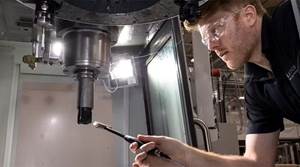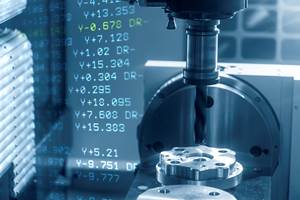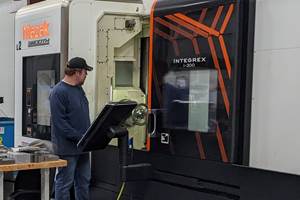It's A Machine Tool Robot
This machine has a dual identity. It looks like an industrial robot. In some applications, such as assembly, it is. However, put a spindle and cutting tool on the end of this five-axis machine and it becomes a machining and drilling center. The inherent stiffness of the machine's tripod design makes it accurate enough to machine aerospace and automotive applications.
Share





This machine has a dual identity. It looks like an industrial robot. In some applications, such as assembly, it is. However, put a spindle and cutting tool on the end of this five-axis machine and it becomes a machining and drilling center. The inherent stiffness of the machine's tripod design makes it accurate enough to machine aerospace and automotive applications.
The machine's manufacturer, Neos Robotics, (Taby, Sweden) has named it Tricept. JMC Technology Group, Inc., (Indianapolis, Indiana), is the U.S. importer for the machine. It is available in two models, the TR 600 and the new, larger TM 805.
The first version of this machine tool, the TR600, was developed about five years ago. Its original purpose was for precision assembly applications. Shortly after these machines found work in assembly, it was discovered that they could do very nicely in light milling and drilling applications especially in environments where high flexibility was a requisite.
The business end to the machine is a tripod formed by three servo actuators. These are pre-loaded to be backlash free. At the upper end, each of the three actuators is supported by a universal joint to aid in freedom of movement. At the lower end is a pre-loaded ball joint with three-degrees of freedom. The upper end of the actuators is supported by a hexagonal cast iron frame. The frame is supported by a column-like structure that is tied to the machine base. The overall machine configuration resembles the well-known C-frame machining center design.
The three actuators guide a central, rigid tube that attaches to the hexagonal frame via a universal joint in its center. A gearbox is integrated in this tube and transmits 590 ft/lbs of torque to manipulate the four or five-axis wrist. In its current design, the machine carries an Ibag 60 hp, 24,000 rpm spindle.
The high-speed spindle coupled with interpolated path speeds of 3500 ipm, facilitate high speed machining in a variety of aerospace and automotive applications. Acceleration is 2g and accuracy is 0.0004 inch. The machine uses a proprietary direct measuring system to provide positioning feedback. Working envelope for the larger machine is 98 by 98 by 31 inches.
Siemens CNC and drive systems are used on the machine. To be able to control the motion of the Tricept machine, using conventional NC programs, a real-time conversion software package has been developed. Using this conversion, the CNC understands a NC program that shows tool path and calculates the appropriate three-dimensional vector. The control software consequently handles the parameters of the machine's kinematics. Shopfloor programming changes can be done on the CNC which features a PC front end.
More applications for this machine are emerging. It has already been successfully applied in aerospace and automotive industries. Its flexibility for five-sided machining with the design's speed and rigidity make it a candidate for production applications in the power train and turbine industries as well as mold and die applications.
Just because our metalworking vernacular lacks a term that accurately describes this new machine tool, it doesn't mean the industry can't use it. A good machine, applied well, no matter what it's called, can still make a shop money.
Related Content
How to Mitigate Chatter to Boost Machining Rates
There are usually better solutions to chatter than just reducing the feed rate. Through vibration analysis, the chatter problem can be solved, enabling much higher metal removal rates, better quality and longer tool life.
Read MoreTips for Designing CNC Programs That Help Operators
The way a G-code program is formatted directly affects the productivity of the CNC people who use them. Design CNC programs that make CNC setup people and operators’ jobs easier.
Read More6 Machine Shop Essentials to Stay Competitive
If you want to streamline production and be competitive in the industry, you will need far more than a standard three-axis CNC mill or two-axis CNC lathe and a few measuring tools.
Read More5 Tips for Running a Profitable Aerospace Shop
Aerospace machining is a demanding and competitive sector of manufacturing, but this shop demonstrates five ways to find aerospace success.
Read MoreRead Next
AMRs Are Moving Into Manufacturing: 4 Considerations for Implementation
AMRs can provide a flexible, easy-to-use automation platform so long as manufacturers choose a suitable task and prepare their facilities.
Read MoreMachine Shop MBA
Making Chips and 91ÊÓƵÍøÕ¾ÎÛ are teaming up for a new podcast series called Machine Shop MBA—designed to help manufacturers measure their success against the industry’s best. Through the lens of the Top Shops benchmarking program, the series explores the KPIs that set high-performing shops apart, from machine utilization and first-pass yield to employee engagement and revenue per employee.
Read MoreLast Chance! 2025 Top Shops Benchmarking Survey Still Open Through April 30
Don’t miss out! 91ÊÓƵÍøÕ¾ÎÛ's Top Shops Benchmarking Survey is still open — but not for long. This is your last chance to a receive free, customized benchmarking report that includes actionable feedback across several shopfloor and business metrics.
Read More





















